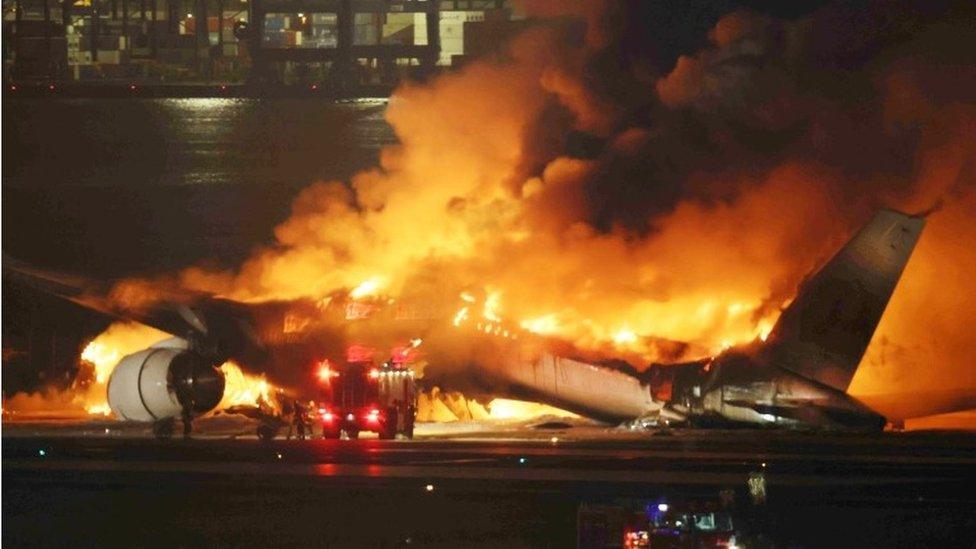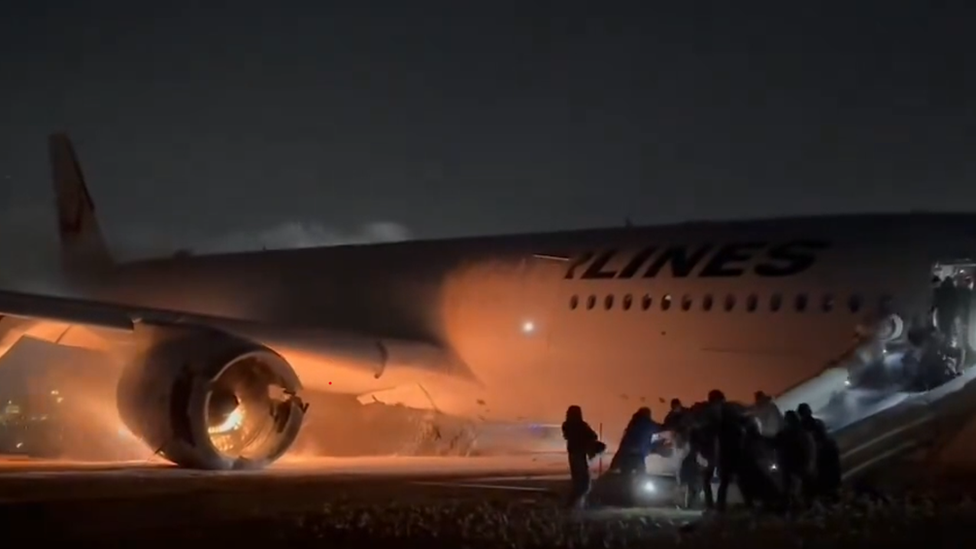Japan jet crash: How crew pulled off flawless evacuation from plane inferno
- Published
Watch: Aerial footage shows burned out shell of Japan plane
Passengers dashed to the emergency exits of a burning Japan Airlines jet without their hand luggage, in compliance with the flight crew's instructions.
The simple act of leaving their valuables behind would be a "major factor" behind the speed of the evacuation, with the last person escaping just before the aircraft was engulfed in flames on the runway of Tokyo's Haneda Airport on Tuesday, aviation experts say.
Japan Airlines Flight 516 turned into a fireball after it collided with a coastguard plane as it landed. Five of the six people on board the smaller aircraft - which had been due to deliver aid to victims of the powerful New Year's Day earthquake - died.
But everyone on Flight 516 survived, with the flawless evacuation from the cabin as it filled with smoke astounding the world and winning praise from many. Aviation experts and industry professionals told the BBC it boiled down to staff on board putting their rigorous training into practice and "well-behaved" passengers who obeyed safety protocols.
"I don't see a single passenger on the ground, in any of the videos I've seen, that has got their luggage with them… If people tried to take their cabin luggage, that's really dangerous because they would slow down the evacuation," said Prof Ed Galea, director of the fire safety engineering group at the University of Greenwich in London.
To see what happens when passengers try to take their luggage with them, one only has to look back to a crash landing in Dubai in 2016. Footage from inside the Emirates Boeing 777 involved shows people panicking as they clamber to grab their possessions, before they fled down emergency slides.
The crew were praised for their efforts to evacuate passengers, and luckily all 300 on board the Dubai flight survived - but the video from inside that aircraft contrasts starkly with the well-drilled scenes witnessed in Tokyo on Tuesday.
Safety training kicked in
A former Japan Airlines flight attendant told the BBC that passengers on Tuesday's flight - which had departed from Sapporo's New Chitose airport at 16:00 local time (07:00 GMT) and landed at Haneda shortly before 18:00 - were "incredibly fortunate".
In the end, just one passenger on board flight 516 sustained bruises and 13 others requested medical consultations due to physical discomfort, the airline said.
"I felt relieved to find out that all the passengers were safe," the former flight attendant said. "But when I started thinking about the emergency evacuation procedure, I suddenly felt nervous and fearful.
"Depending on how the two planes collided and how the fire spread, it could have been a lot worse."
According to the former attendant, all new crew members undergo stringent evacuation and rescue training for up to three weeks before they are allowed to serve in commercial flights. The training - which extends to how you control the tone and volume of your voice so you can be best heard by passengers - is repeated every year.
"We go through a written exam, case study discussions and practical training using different scenarios, such as when the plane has to make a water landing or if there is fire on board. Maintenance staff are also involved in such training," said the former flight attendant, who left the airline 10 years ago.
On top of this, all aircraft manufacturers must show that everyone aboard can leave the plane within 90 seconds for their planes to be internationally recognised.
But even so, in real-life situations, it can be difficult to ensure that passengers do not panic, said the former flight attendant, who spoke on the condition of anonymity.
"What they achieved is harder than one can imagine. The fact that they managed to get everyone to escape is a result of good co-ordination among crew and passengers following instructions," she said.
A pilot for a South East Asian airline, who also spoke on the condition of anonymity, agreed that the flight crew's rigorous training was key to the passengers' escape.
"I must say it was amazing," he told the BBC. "You really don't have time to think in a situation like this, so you just do what you were trained to do."
It is all the more impressive when you take into account the position and condition of the aircraft, which - according to Prof Galea - would have made the evacuation all the more tricky.
"This accident was far from ideal. The aircraft was nose down, which meant it was difficult for passengers to move," he said.
Only three inflatable slides could be used to evacuate passengers, but they were not properly deployed because of how the jet landed. The rear slide was very steep, which could have been dangerous.
The aircraft's announcement system also malfunctioned during the evacuation, so the flight crew had to convey instructions using a megaphone and by shouting, Japan Airlines said.
But there were also signs the aircraft's design was working to give those on board the best chance of escape. Prof Graham Braithwaite, director of transport systems at Cranfield University in the UK, told the BBC it looked like it "has done what it is designed to do, which is protect the occupants and allow a fast evacuation".

The role of the airport's fire crews on the ground - who, according to Prof Braithwaite, aim to get to any fire within two minutes - would also have been key in ensuring there was time to escape.
"The fire service focus will absolutely have been on protecting the exits and making sure there was a clear path for people to evacuate," he said. The larger fire, he explained, would only have been dealt with after the last person escaped.
Lessons have also been learned from the past, with aviation safety regulations significantly strengthened after previous accidents, the pilot told the BBC.
For instance, the collision of two Boeing 747 jets at Los Rodeos Airport in Tenerife in 1977 - which killed 583 people and remains the deadliest accident in aviation history - led to a review of cockpit procedures and radio communications. The crash was found to be due to miscommunication between flight crew and air traffic controllers.
An investigation is currently under way into what caused Tuesday's runway collision in Tokyo but, according to transcripts of conversations with the control tower which emerged on Wednesday, the coastguard plane had not been cleared for take-off while the passenger plane was given permission to land.
Japan Airlines experienced its own catastrophe in August 1985, when Osaka-bound Flight 123 crashed into a mountain shortly after take-off from Tokyo Haneda. It was later attributed to faulty repair work by Boeing, the aircraft manufacturer. Only four out of 524 people on board survived the crash.
The airline's record has been "blemish free" since then, Prof Braithwaite told the BBC, and it is a "world leader" when it comes to safety.
Management at the company are so dedicated that in 2006, Japan Airlines opened a museum-like facility near Haneda displaying wreckage from the incident, aimed at promoting safety awareness among its employees.
"In face of the pain and grief of the bereaved families and public distrust in airline safety [after the 1985 crash], we pledged that we would never again allow such a tragic accident to occur," Japan Airlines wrote on the facility's webpage, external.
"Every member of staff is reminded that valuable lives and property are entrusted to us in our work."
Additional reporting by Mariko Oi

Sign up for our morning newsletter and get BBC News in your inbox.

- Published2 January 2024

- Published2 January 2024
